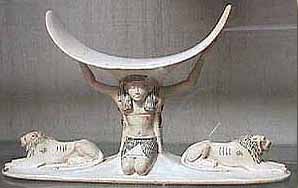
Shu
Symbols: ostrich feathers, wind, flags, lion
Cult Center: Heliopolis
His name means "dry, parched, withered." He was asssociated with the heat of the sunlight and the dryness of the air. Shu considered the god of the space and light between the sky and the earth. Shu was believed to also hold power over snakes and he was the one that held the Ladder the deceased used to climb to heaven.
As Lord of the Air or Atmosphere, it was Shu's duty to seperate his children: the sky (the goddess Nut) and the earth (Nut's husband, Geb). His eternal occupation was holding Nut up above Geb. It was said that if he ever was removed from his place, Chaos would come to the Universe.
Many images show him holding up his daughter, while his son reclines beneath him.He was the brother and husband of Tefnut and they were usually mentioned together. It was said that Shu and Tefnut were two parts of one soul. Oddly, Shu and Tefnut do not appear to have any city of distrct especially dedicated to them.
Shu was also the son of Re or Atum and, as mentioned previously, the father to Geb and Nut.The oldest myth about the origin of Shu states that once upon a time the god Atum went to the city of Annu and he created Shu and Tefnut from his own body through masterbation.
In the story of the creation, Atum is described as saying: "I had union with my hand, and I embraced my shadow in a love embrace; I poured seed into my own mouth and I sent forth from myself issue in the form of the gods Shu and Tefnut.
" Later myths called this story into doubt and claimed that Atum's shadow acted the part of his wife; still others state that the goddess Iusaaset was Atum's wife. Shu is shown as a man who wears on his head one to four feathers. Some figurines show him holding up the sky with his two hands.